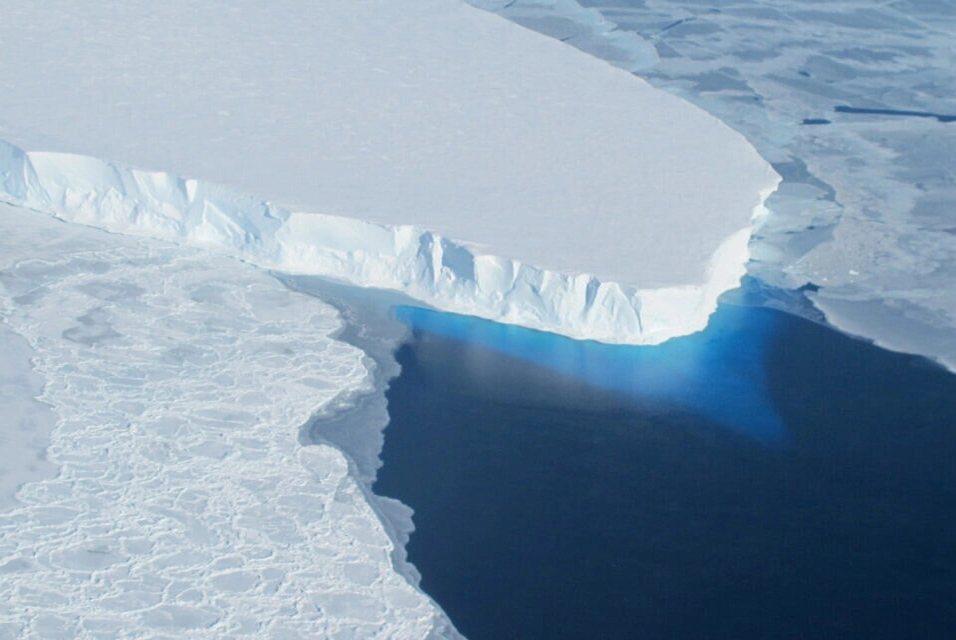STANFORD, CA.- In West Antarctica, the 80-mile-wide stream of sliding ice at the heart of Thwaites Glacier is likely to creep outward over the next 20 years, a change that could speed up ice loss, new research finds.
"It's like a torrential river eating away at the riverbanks and widening in the process," said senior study author Jenny Suckale, an assistant professor of geophysics at the
Stanford Doerr School of Sustainability.
Thwaites Glacier is often called the "doomsday glacier" because of its massive size and potential to dramatically raise global sea levels. As the world warms, it could drop billions of tons of ice into the Amundsen Sea and open a path for more inland ice to flow freely to the coast.
Many previous studies have examined how the glacier's speed and thickness are likely to evolve over centuries. Less research has focused on the glacier's width, which influences how much ice collapses into the sea in any given timeframe. Widening of the main ice stream, or trunk, could exacerbate instability, while narrowing could effectively hit the brakes on ice loss by allowing a new balance of forces.
The new research, published March 7 in Journal of Geophysical Research: Earth Surface, uses numerical modeling to show how Thwaites Glacier's rapid but uneven thinning could affect the eastern and western margins of its main trunk.
'Relative stability' remains possible
Led by geophysics Ph.D. student Paul Summers, the researchers found that the observed thinning of Thwaites Glacier, together with changes in the slope of its surface and the conditions at its base, makes both sides prone to move a few miles outward over the next 20 years.
"We are considering relatively small changes in driving stress as would realistically occur in the coming two decades," Summers and colleagues write. Yet even this subtle widening—only about 2% of the glacier's overall width—could speed up ongoing ice loss.
"If the widening trend were to continue and were to accelerate, then we'd better know. It would mean that we would have to prepare for higher sea levels," said Suckale, who is one of dozens of scientists working to understand the glacier and its response to climate change as part of the International Thwaites Glacier Collaboration.
For some places, existing models predict sea levels may rise only an inch or two, or as much as a few feet in the coming decades. "The policy actions you would have to consider from one extreme to the other are completely different," Suckale said, ranging from improving flood management and drainage for infrastructure near shorelines to relocating entire coastal communities.
The "doomsday" scenario, however, is only one of "many, many possibilities," said Suckale. "Stability is still well within the possibilities for Thwaites Glacier—at least, relative stability."
Determining just how much Thwaites's disintegration may accelerate as a result of its widening ice stream would require scientists to update existing ice-loss models, which generally simplify the processes captured in the new research. "We are trying to get at something more basic, which is the nature of the trend: widening, neutral, narrowing," Suckale said.
Monitoring Thwaites like a coming storm
Summers said the research team had expected their modeling to show the glacier's eastern shear margin to be most susceptible to migrating away from the main trunk. They were surprised to find that in some scenarios, the western boundary appears prone to widening as well.
This discovery underscores the importance of expanding research efforts on the western margin, in addition to work already focused on the eastern side, where Summers spent several weeks last year digging up seismic sensors and GPS systems and surveying the ice with ground penetrating radar as part of a team deployed by the U.S. Antarctic Program.
Previous models have sought to predict global sea levels hundreds of years into the future or capture the ice dynamics at Thwaites Glacier in its entirety. Modeling ice sheet evolution and global sea level rise over these longer time scales produces dramatic predictions, Suckale said, but also huge barriers to testing against real-world data because scientists have been able to collect so few direct measures of how ice sheets are changing in the face of global warming.
"We are very intentionally focusing on the next two decades to enable testability and continued model development," said Suckale. Next steps include testing the model results against geophysical measures of ongoing changes at two field sites along the eastern shear margin, and a third field site focused on what's happening below the main trunk.
"It's kind of like weather predictions. You monitor the storms as they come in, and then you update your predictions and pass that information on. I think we need to monitor Thwaites and make sure we have ways to get that information into planners' hands," Suckale said. "We don't need to hit the panic button, but we also can't ignore this."










